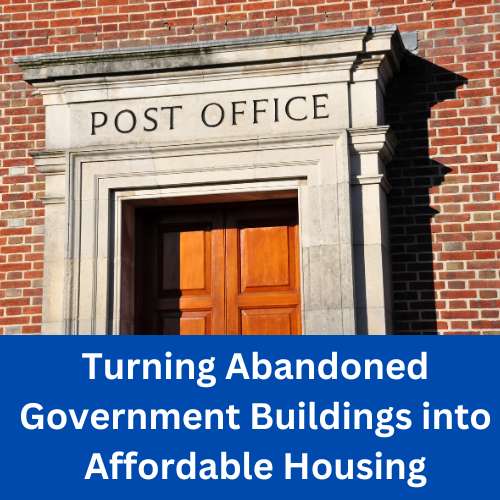In fenestration manufacturing, the hum of saws, drills, and air compressors is a constant. But…

Turning Abandoned Government Buildings into Affordable Housing: A Window of Opportunity for the Fenestration Industry
As discussions around the housing crisis intensify, governments at every level are
searching for creative and cost-effective ways to deliver affordable housing. One
increasingly discussed solution is repurposing abandoned government buildings—old
courthouses, shuttered schools, disused post offices—into residential units or
demolishing them to build new housing on the land. In April of 2024, Rep. Adam Schiff
introduced a new bill, the Government Facilities to Affordable Housing Conversion Act.
If passed, the bill would create an annual report on government properties that are
suitable for residential reuse and the bill would provide $250 million each year from
fiscal year 2025 to 2030 to incentivize conversion projects.
For the window and door industry, this trend is more than a public policy shift—it’s a
potential boom in demand and innovation.
The Housing Crisis Meets Government Real Estate
Across the U.S., a surprising amount of publicly owned real estate sits vacant. It is
estimated that the U.S. government owns 45,000 underutilized buildings. These
properties—sometimes in prime urban locations—are costly to maintain and provide no
public benefit in their dormant state. Transforming these abandoned government buildings into affordable
housing is a win-win: it reduces urban blight, utilizes taxpayer assets effectively, and
addresses a pressing social need. But reuse and new construction on these sites requires significant
renovation—particularly when it comes to windows and doors.
Why This Matters to the Window and Door Industry
Surge in Retrofit Projects
Many government buildings slated for conversion are decades old, often poorly
insulated and fitted with outdated, inefficient windows and doors. Bringing them up to
residential standards means a surge in retrofit demand—double-pane windows, energy-
efficient frames, soundproof doors, and ADA-compliant entryways.
For manufacturers and installers, this creates a new niche: customizing products for
adaptive reuse projects that must balance modern performance with architectural
preservation.
Sustainability Requirements
Government-funded housing projects typically have strict environmental standards. This
puts high-performance, Energy Star-rated windows and doors front and center. Our
industry has an opportunity to lead here—supplying products that reduce energy costs
for residents while helping developers meet LEED and other green building
certifications.
Volume Orders and Long-Term Contracts
If federal or state governments scale this strategy nationally, it could result in long-term
contracts for bulk orders of windows and doors. Procurement at scale would benefit
suppliers that are ready to deliver standardized, compliant products efficiently. Window
and door companies that invest in manufacturing capacity and streamlined logistics
could position themselves as preferred partners.
Opportunity for Innovation
Some buildings will require more than a one-size-fits-all solution. Converting a 1930s
courthouse into housing? You’ll need custom historic-style windows that meet modern
codes. Turning a school into multi-family units? That’s a chance to rethink interior door
design for privacy, fire safety, and sound reduction.
Innovation in materials (like fire-rated glass or recycled composite frames) and smart
technology (such as integrated window sensors or security access systems) can help
window and door companies differentiate themselves in a competitive bidding
landscape.
Challenges to Watch
Of course, challenges remain. Government projects are known for lengthy procurement
processes, budget constraints, and shifting political winds. Not all window and door
companies are equipped to deal with the bureaucratic complexities of public contracts.
Still, those who can navigate these waters—especially companies with experience in
commercial retrofits or institutional projects—will be well positioned to grow.
Conclusion: A Future Built on Frames and Foundations
At Wakefield Equipment, we view the transformation of abandoned government
buildings into affordable housing not just as a policy headline, but as a market signal.
This is a chance to provide real value—to contribute to sustainable, equitable housing
while expanding our footprint in a socially meaningful way.
We should prepare now: by scaling production, sharpening compliance know-how,
innovating in product design, and building relationships with public-sector developers.
After all, every new home starts with an opening. And no one understands openings
better than us.



